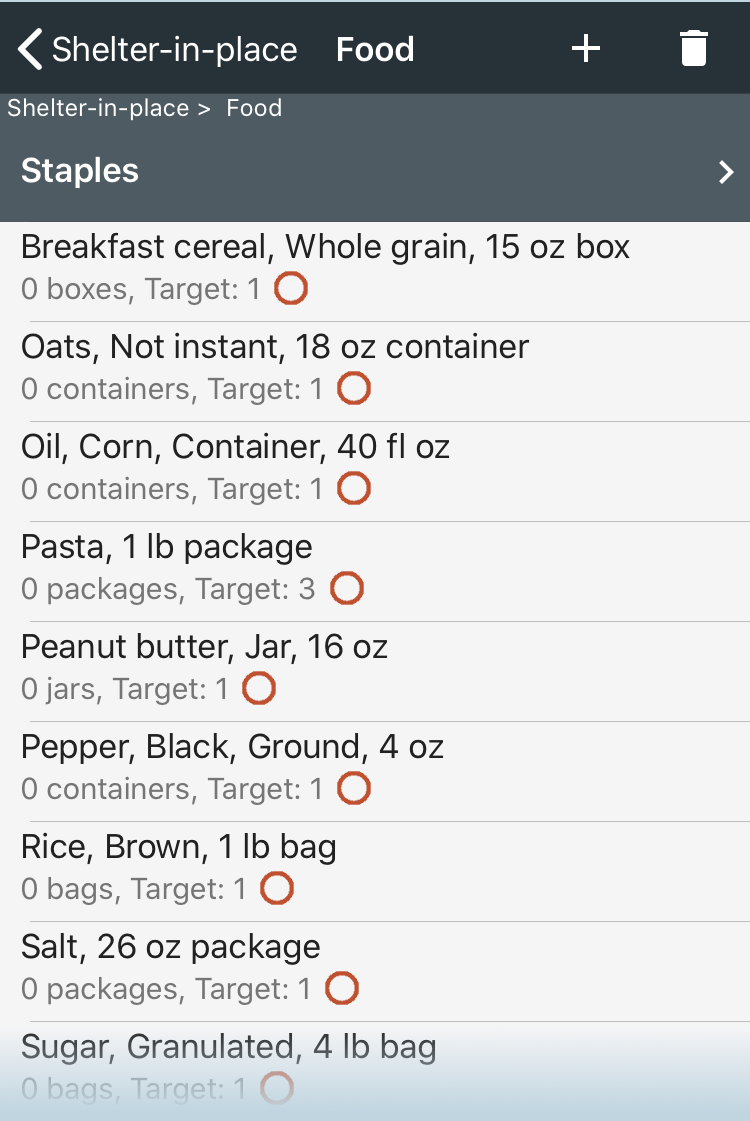The food plans explained
June 5, 2020
Overview
When you choose the Shelter-in-place option during the Inventory Wolf onboarding questionnaire, you’ll be setup with a food plan in your Shelter-in-place cache. Acquire all the items in that plan, and you’ll be set food-wise for the time period you chose (2 weeks, 1 month, or 2 months). That food plan is based on 2020 USDA Dietary Guidelines and a 2000 calorie daily intake.

Impetus
When researching survival food plans to build Inventory Wolf‘s recommendations, the plans I found didn’t satisfy me. Being a bit of a health nut, I also had concerns with the nutritional balance of what I found. So I decided to build the food plan recommendations from scratch, using the 2020 USDA Dietary Guidelines (published jointly by the US Departments of Agriculture (USDA) and Health and Human Services (HHS) every five years).
Method
Of particular use was Table 1-1. Healthy U.S.-Style Eating Pattern at the 2,000-Calorie Level, With Daily or Weekly Amounts From Food Groups, Subgroups, & Components.

Calories
The USDA Guidelines also provide estimates of calorie needs per day. For example, it lists 2400 calories and 1800 calories for 30-year-old sedentary males and females, respectively. I set the food plans to 2000 calories per day, irrespective of sex and activity levels, and rounded up to full containers. The reasoning is:
- The higher needs for males would average out with the lower needs for females and children
- If you are sheltering in place, you won’t be too active
- People typically buy “a little extra” when survival food shopping
If your household has a higher male-to-female/child ratio, or plans to be more active while weathering disasters, or lives in winter storm climates, be sure to buy “a little extra” when shopping for these items.
Process
I went through each of the food groups and the foods that make up each group, and drawing from both my own prepping experience and fellow preppers, I identified food candidates that met the following criteria:
- Relatively shelf-stable. It needs to be storable on shelves or in bins, not requiring refrigeration, and not expire or lose its nutritional value too soon. Canned food is a good choice here as our friends at the USDA tell us, “High acid foods such as tomatoes and other fruit will keep their best quality up to 18 months; low acid foods such as meat and vegetables, 2 to 5 years.“
- Relatively easy to prepare. Cooking abilities such as heating food up, cooking pasta and rice, making pancakes from a mix, etc, should be sufficient.
- Relatively easy to find in normal grocery stores in your area. Some items, such as freeze-dried scrambled eggs, you’re most likely only going to find in a store with hiking and camping gear, or on-line of course.
Once I had candidates for each of the food groups, I calculated quantities for 2-week, 1-month, and 2-month periods, adding additional variety for each successive time frame. You could simply multiply your 2-week plan by 4 to get a 2-month plan, but eating the same foods day in and day out during a disaster is not going to be good for your morale, or health.
Lastly, I added some comfort and snack foods, again increasing variety the longer the period, to arrive at the final plans.
Substitutions
Hate canned carrots? Allergic to nuts? No problem, you can substitute something else. The trick is to substitute from the same food group. That will probably mean spending some time understanding the food groups, but that will be time well spent. If you’ve already got the Dietary Guidelines open, they do a good job of explaining the different food groups and you’ll see that carrots, for example, are in the Red & Orange Vegetables group. But before you simply double up on sweet potatoes, keep in mind, you want variety, so pick something else like pumpkin instead.
Note: The Notes field of each food in recommended inventories lists its food group for your convenience.
Tips and Tricks
- Expiry dates. Be sure to set the food item’s expiry date in Inventory Wolf, then you can view the Expiring Items report to see what items need to be replaced so that your supplies aren’t stale when you need them/
- Storage. Keep food stores off the ground and cool
- Rotation. Instead of waiting for food to expire, and then throwing it out, consume it before it expires, and then buy replacements. No wasted food/money.
- Recording multiple expiry dates. If you have two sets of jars of spaghetti sauce, each with different expiry dates, just have an Inventory Wolf item for each set, then you can assign each set its own expiry date.
